Infrastructure Investment Cools in Several Provinces

Several provinces saw growth in infrastructure investment drop — or even the total amount of investment decline — in the first quarter as the central government tightens the rules for government local debt issuance and public-private partnerships (PPPs).
Hunan province was the region that was hit hardest by the waning momentum of infrastructure investment, which has long served as a key driving force for many local economies. During the first three months of 2018, infrastructure investment in the Central China province declined by 1.7% year-on-year, down from growth of 15.9% for the whole of 2017 and making the first drop in five years.
The provincial Bureau of Statistics attributed the decline to stepped-up scrutiny over local PPP projects and measures put in place to prevent local governments from reckless borrowing. It said the central bank’s neutral monetary policy has also been a factor in the investment slowdown.
The central government originally promoted PPPs to attract private capital to fund public projects such as roads, bridges, hospitals and clinics in order to alleviate financial pressure on local government coffers, but the programs were often used to further fuel and disguise local government borrowing sprees.
Preventing and defusing financial risks will be one of the country’s top three priorities over the next three years, according to a key report issued during the Communist Party’s national congress last year.
In accordance with the central government’s focus on risk control, the Hunan government in April urged localities to overhaul their infrastructure projects and revise debt risks. Many local infrastructure projects have been canceled or suspended since then in a bid to prevent debt from spiraling out of control.
Niu Bokun, economist-in-chief at Hua Chuang Securities, who conducted field research in Hunan, thinks that these cancellations and suspensions are the prime cause of the drop in infrastructure investment in the January-through-April period.
As of the end of April, Hunan has disqualified 145 PPP projects involving 190.9 billion yuan ($29.74 billion), ranking second nationally in terms of total investment involved in cancelled PPP projects. In that, the province trails only the Inner Mongolia autonomous region, where several cities were ordered to stop building subway systems.
Anhui, Hubei, Hainan, Hebei and Jiangsu provinces, as well as the Xinjiang Uygur autonomous region, saw their infrastructure investment growth rates decline during the first quarter.
Liang Hong, chief economist with Chinese investment bank CICC, said most regions that have canceled PPP projects are not in good fiscal shape, and that regions such as Shanghai and Guangdong — where local governments are not suffering from financial difficulties and investment is better planned — will not be affected.
During the first four months of the year, Shanghai infrastructure investment grew 16.4%, while Guangdong’s increased 11.9%.
Contact reporter Pan Che (chepan@caixin.com)

- 1PDD Fires Government Relations Staff After Fistfight With Regulators
- 2China Ramps Up Effort to Offload Vast Supply of Unsold Homes
- 3China’s Elite-Focused Schools Are Failing Most Students, Top Educators Say
- 4In Depth: China’s Developers Try to Modernize After Surge in Subpar Homes
- 5Cover Story: Trading by Algorithm: Who is Responsible When AI Calls the Shots?
- 1Power To The People: Pintec Serves A Booming Consumer Class
- 2Largest hotel group in Europe accepts UnionPay
- 3UnionPay mobile QuickPass debuts in Hong Kong
- 4UnionPay International launches premium catering privilege U Dining Collection
- 5UnionPay International’s U Plan has covered over 1600 stores overseas






